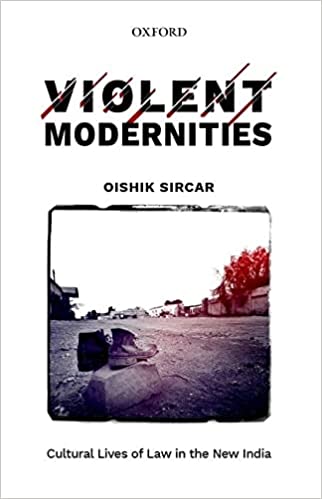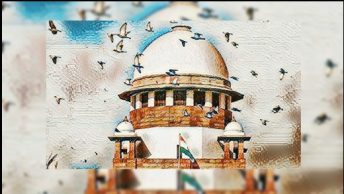Oishik Sircar’s Violent Modernities. Cultural Lives of the Law in India, is a collection of essays researched and written over a decade beginning 2008, published at different times and places, in which he later recognized “keynotes resonating through the pieces.” The essays in Violent Modernities come together through the argument that “legal imagination in India does not only emanate from courtrooms, legislations and judgements, but is lived in the practices of ordinary disobediences and everyday failures, in the cultural chronicles of life in literature, cinema, art and the practices of pedagogy.”
This is therefore an eclectic collection of Oishik’s work over the period. The first chapter offers a critique of rights-based liberal faith in constitutionalism, an argument that carries into the second chapter, a study of how liberal human rights discourse depoliticizes citizenship claims made by sex workers’ children who do not disown their mothers’ work.
Chapters 3 and 5 arise out of reflections on the anti-Muslim pogrom in Gujarat in 2002; the former through close reading of a film, and the latter through a self-reflective essay on returning to Gujarat ten years after the violence and confronting the ethical dilemmas of memorializing mass violence as one who was not affected or targeted by that violence.
Chapter 4 addresses the neoliberal and Hindu nationalist strands of the “new” queer politics in India, Chapter 6 is an analytical tribute to critical legal theorist and law professor Upendra Baxi; and the final chapter traces the journey that Oishik has made as a “male feminist legal scholar inside the neoliberal university.”
In this response to the book, I will use Oishik’s argument about rights, as a springboard to enter one particular whirlpool in critical legal thinking in 21st century India, which anybody in the field would have attempted to negotiate at some point. I use the term whirlpool to indicate a space in which our understanding and arguments tend to swirl around over time rather than moving in a linear fashion from we-used-to-think-that to now-we-think-this.
The whirlpool I draw attention to here is around the critique of law as the vehicle of rights, and of constitutionalism as an ethical horizon. The initial modernist faith in the law as the counter to violence faced a philosophical challenge from the mid-20th century onwards. Scholarship across the globe during this period pointed to the violence of the law itself, both as an ordering principle and as the vehicle of violent imperialist transformation of heterogeneous ways of life and property regimes. The decades that followed have problematized the assumed universalist basis of rights as emancipatory and, in addition, pointed to their contemporary weaponization by US imperialism. In earlier works I have referred to the “paradox of constitutionalism” in this context, an idea to which we will return. In short, as Oishik too holds, the language of rights and citizenship is not unproblematically available to emancipatory politics. For instance, the essay on children of sex workers (written with Debolina Dutta) counterposes with clarity the abolitionist rescue model of films like Born into Brothels that are based on the principle of violation of child rights, against the agency of the children themselves, expressed through the collective they run, Amra Padatik. Experiencing the state and the law only as violence, they nevertheless struggle to be active citizens and to carve out lives of dignity while not disowning their mothers’ lives.
This space of critique of the rights discourse, law and the state as disempowering, acquires the counter currents of its whirlpool character today, from the powerful reanimation of the Indian constitution over the past decade or so.
In April 2019, on the eve of the general elections that would bring the BJP into power for a second term, performance artist Maya Rao staged an event at a Women’s March. She ceremoniously stripped herself of her sari, and then slowly re-clothed herself with cloth inscribed with the values of the Preamble to the Constitution – Equality, Liberty, Fraternity. This performance invokes the scene from the Mahabharata, of the stripping of Draupadi in the royal court, and her being saved from public nudity by the god Krishna who miraculously lengthens her strip of cloth indefinitely. Here, Rao draws on the wellspring of Hindu culture to subvert it, and to indicate instead, that the protection of the powerless will today emanate from the Constitution.
Jignesh Mevani, s charismatic young Dalit leader and now a member of the Gujarat state legislature, said before the 2019 elections, that he would place the Constitution and the Manusmriti, the ancient text that sets out the hierarchical caste system, before the Prime Minister and ask him to choose between them. Mevani was referring to the police complaints against himself and other activists, and their potential arrests for attending a massive assembly of Dalits at Bhima Koregaon. Similarly, Chandrashekhar Azad, founder of the Bhim Army, a mass social movement for dignity for Dalits, has been arrested more than once. At his meetings, attended by thousands of Dalit youth, he routinely holds up a Hindi copy of the Constitution. This dramatic counter-position of the Constitution to the caste order has a long history going back to B.R. Ambedkar and highlights the insurgent possibilities in the Indian Constitution.
Similarly, the passing of the Citizenship Amendment Act [“CAA’] in December 2019, excluding Muslims of neighbouring countries from seeking refugee status in India, which the BJP Home Minister indicated was the first step towards disenfranchising Muslim citizens of India (although later he denied this), evoked massive country-wide protests, led by Muslims, but including all sections of society. These protests, beginning at the end of 2019, and continuing with vigour until Covid restrictions began to be implemented with severity in March 2020, were remarkable for their performances of the Preamble to the Constitution that guarantees equal rights to all citizens. The 24-hour sit-ins occupied public spaces for months in different parts of the country, the sites became festivals celebrating the Constitution through music, dance, spoken word performances, speeches, wall art, and periodic recitations of the Preamble. In addition, public readings of the Preamble were organized at several sites across the country, where hundreds of people would show up just to read aloud the Preamble in different local languages as well as in English. Women overwhelmingly led these protests. The most well-known of these protest sites is Shaheen Bagh, a Muslim neighbourhood in Delhi, which has acquired iconic and legendary status.
Then there is the Pathalgadi movement that has swept across the tribal belt of the states of Jharkhand, Chhattisgarh and Odisha since 2016, which has reworked a tradition of putting up stone slabs across their lands for various purposes (such as during the last rites of a person who has died), in a way as to directly politicize it. Many of these giant green stone slabs now directly invoke the Constitution, in which collective ownership of tribal lands is protected by the Fifth Schedule and other specific Articles. These regions have been in ferment for decades, but the immediate trigger for the current militant phase of the Pathalgadi movement can be traced to 2016, when amendments were proposed by the BJP government of Jharkhand, to two key legislations that protect tribal rights to their land. The legislation was passed, but aroused such widespread opposition that it had to be withdrawn. Subsequently, the BJP government at the Centre, in 2017, passed amendments to another legislation, the Land Acquisition Act, 2013. The amendments, which enable the acquisition of tribal land for ‘development’, reduces the scope for social impact assessment and reduces the powers of the gram sabha to merely giving ‘advice’, received the assent of the Governor in 2018. The contemporary political performance of Pathalgadi, through the stone slabs inscribed with portions of the Constitution, is a rejection of this legislation and the assertion of tribal sovereignty over their lands, prohibiting the entry of government officials and other “outsiders”. Many leaders of the movement have been arrested for sedition for this powerful invocation of the Constitution.
Earlier, a mass movement resulted in the Right to Information Act [“RTI Act”], passed in 2005. This legislation was the result of a prolonged public campaign initiated by the Mazdoor Kisan Shakti Sangathan of Rajasthan, which had made use of the idea at the local level to ensure payment of daily wages to casual workers. The RTI Act is nothing more than legal backing for citizens’ right to information from the government. But the notable aspect of it is that the campaign creatively based its claim on the Fundamental Right, Article 19 (1), which says that every citizen has freedom of speech and expression, drawing on a Supreme Court judgement of 1976 which ruled that people cannot speak or express themselves unless they have full and correct information. Therefore, the movement claimed, the right to information is embedded in Article 19.
This simple bureaucratic demand for information from government and government agencies has turned out to be so powerful that time and again, the RTI Act has been sought to be amended to restrict its scope and the powers of RTI officials to do their job. Apart from legal attacks on the RTI Act, there have been innumerable physical attacks on RTI activists, and this dry, legalistic demand for information has turned out to be more courageous and riskier than taking up a gun for revolution. This is because the use of the RTI can unearth deep conspiracies within the bowels of government. According to the Campaign for the Right to Information, media reports of more than 300 instances of attacks on, or harassment of citizens, and at least 51 murders and five suicides can be linked to information sought under The RTI Act since its inception. RTI warriors, armed with nothing more than a form that costs ten rupees, are correctly perceived by power networks to be dangerous enough to kill.
These are just a few instances of the manner in which the Constitution has been owned, reiterated, and performed as the source of political legitimacy by different kinds of movements challenging injustice in the 21st century. The queer campaign against Section 377 of the Indian Penal Code invoked “constitutional morality”, against “popular morality”, while we could say that the movements discussed above call upon constitutional morality against “state morality”, including the law itself.
If the Indian Constitution is being performed as a potentially radically transformative document, even an insurgent one, how do we understand our critique of rights and constitutionalism?
Let us first ask the question – can a constitution be insurgent?
Insurgency implies rising up against established authority, not necessarily with arms. To be insurgent is to resist an established order. How then, can a constitution, as a set of principles which establishes an order, be insurgent?
By using the term “insurgent” alongside “constitution”, I am reformulating my earlier argument regarding the paradox of constitutionalism. By “constitutionalism”, I refer to a specific method adopted by modern democracies of safeguarding the autonomy of the individual self. However, it is now generally recognized that this objective is achieved by a process of enforcing universal norms that marginalize, render obsolete and de-legitimize contesting worldviews and value systems. This particular method of organising democracies has a specific history and arose in a particular geopolitical location – that is, in Europe in the 17th century. By historicising this method, we remind ourselves, to use Upendra Baxi’s words, that “much of the business of ‘modern’ constitutionalism was transacted during the early halcyon days of colonialism/imperialism. That historical time-space marks a combined and uneven development of the world in the processes of early modernity…[C]onstitutionalism inherits the propensity for violent social exclusion from the ‘modern’.”
The drive of constitutionality then, is towards the erasure of any kind of normative ethic which differs from its own unitary central ethic.
The dilemma that faces radical politics is what I termed the “paradox of constitutionalism” – that is, the tension in which the need to assert various and differing moral visions comes up against the universalising drive of constitutionality and the language of universal rights.
A constitution is usually seen as a legal document that embodies a certain new dispensation or structure of power and which becomes our reference point in the resolution of disputes among different sections of people. Thus, Marxists for instance, might characterize a constitution as bourgeois or socialist – and there certainly is an element of truth in the characterization of many modern constitutions as bourgeois, in that they protect property rights and civil rights, but not economic democracy. However, that does not exhaust the full meaning of what constitutions are, for what we see in contemporary India is that the Constitution no longer lives the singular life that liberal constitutionalism laid out for it, but has become, for many sections of the population, a call to radical transformation as well. The Constitution has broken out of the confines of the liberal imagination that attempts to keep it in the safe custody of constitutional experts.
There are two reasons for this. First, the Indian Constitution is not merely a liberal document in any sense. Constitutional Assembly debates reflect a variety of political opinions from the Left to the Right, emerging from a mass anti-imperialist struggle. The Constitution therefore continuously negotiates individual and community, equality among individuals and special provisions for historically disadvantaged groups, the drive towards industrialization and rights of the peasantry. This mid-20th century moment is very different in time and space from the time period that produced the constitutions of the West, which marked a closure of, and an end to political ferment. The Indian Constitution on the contrary, is seen by all participants as the beginning of a journey towards what the preamble promised. The destination of this journey is viewed differently by different participants, and this is what enables multiple visions to coexist in the document. Thus, the Indian Constitution does not express a singular will and a singular order.
In this I disagree with Feisal Devji who terms the Indian Constitution a “document of conquest” (Devji 2021), similar to the Euro American Constitutions of the 17th to 18th century. His analysis rightly tracks the heterogeneous competing visions that come together around the Indian Constitution, but then translates them through the lens of “American” and “French” constitutional experience, hence losing the specificity of time and place that should be central to all theorizing. I am also puzzled by his characterizing of French constitutionalism as involving the acceptance of positive discrimination, when in my view it embodies the quintessential Enlightenment perspective demanding elimination of all difference. I hope to engage more systematically with Devji’s argument elsewhere, and to continue the conversation, but suffice it to say that at this moment in history, it seems there is a way in which a certain static understanding of secularism as referring to the interrelationship of settled religion–based communities has acted as a “misdirect”, drawing our attention away from the dynamism of a dense undergrowth of other relations, identities and power structures that remain out of sight, ungrasped, untheorized.
The second reason why the Constitution is emerging as the banner of revolt for some struggles is the nature of Indian democracy, which has rarely remained confined to participation in elections. Of course, there are many movements that would not accept the Indian Constitution as a basis of legitimation, but here I am talking only about movements that do express their anger towards governments by reasserting their vision of the Constitution. The explosion of mass movements across the country over the past decades, and especially over the term of the ongoing regime of the BJP since 2014, is an indication that continuous democratic participation in decision making has come to be taken for granted by the people. There is thus a growing divide between the people and the ruling elites, including all political parties, with the Constitution standing by the former, while the state and the law are deployed by the latter
In other words, the Indian Constitution is not a document that has managed to establish one unitary order. If it was meant to legitimize the brahminical, patriarchal, class society that India is, it certainly failed, for it ended up reflecting the heterogeneity of impulses of the anti-imperialist moment. It ended up therefore, being a porous document with one foot in the future. While I do not suggest that the Constitution exhausts all possibilities for radical politics, it certainly seems to offer to some kinds of movements, the resources to think in radically transformative terms. We have discussed only 21st century democratic practice but Rohit De, for one, has indicated such a potential being discovered in the Indian Constitution from its inception.
What we see then, is this document oriented towards multiple visions of justice – the Indian Constitution – being deployed creatively in different contexts to deflect the violent closures of the state and its law. I think Oishik would agree with me that our critique of rights, law and the state must negotiate this whirlpool produced by democratic practice in India today.
Nivedita Menon is Professor at the Centre for Comparative Politics and Political Theory, Jawaharlal Nehru University, New Delhi.






[…] Posted byNivedita Menon […]
Your article helped me a lot, is there any more related content? Thanks!
Thanks for sharing. I read many of your blog posts, cool, your blog is very good.